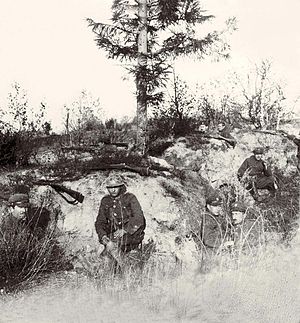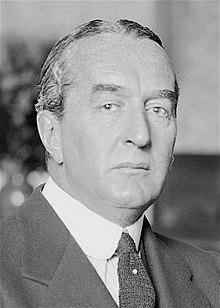Portal:1920s
The 1920s Portal
Silent films were popular in this decade, with the highest-grossing film of this decade being either the American silent epic adventure-drama film Ben-Hur: A Tale of the Christ or the American silent war drama film The Big Parade, depending on the metrics used. Sinclair Lewis was a popular author in the United States in the 1920s, with his books Main Street and Elmer Gantry becoming best-sellers. Best-selling books outside the US included the Czech book The Good Soldier Švejk, which sold 20 million copies. Songs of this decade included "Mack the Knife" and "Tiptoe Through the Tulips". During the 1920s, the world population increased from 1.87 to 2.05 billion, with approximately 700 million births and 525 million deaths in total. (Full article...) Selected article -The Battle of Radzymin (Polish: Bitwa pod Radzyminem) took place during the Polish–Soviet War (1919–21). The battle occurred near the town of Radzymin, some 20 kilometres (12 mi) north-east of Warsaw, between August 13 and 16, 1920. Along with the Battle of Ossów and the Polish counteroffensive from the Wieprz River area, this engagement was a key part of what later became known as the Battle of Warsaw. It also proved to be one of the bloodiest and most intense battles of the Polish–Soviet War. The first phase of the battle began on August 13 with a frontal assault by the Red Army on the Praga bridgehead. The Russian forces captured Radzymin on August 14 and breached the lines of the 1st Polish Army, which was defending Warsaw from the east. Radzymin changed hands several times in heavy combat. Foreign diplomats, with the exception of the British and Vatican ambassadors, hastily left Warsaw. (Full article...)Featured picture Haile Selassie I was Ethiopia's regent from 1916 to 1930 and Emperor of Ethiopia from 1930 to 1974. The heir to a dynasty that traced its origins to the 13th century, and from there by tradition back to King Solomon and the Queen of Sheba, he is a defining figure in both Ethiopian and African history. Selassie is revered as the religious symbol for God incarnate among the Rastafari movement, whose name comes from Ras (literally "Head," an Ethiopian title equivalent to Duke), and Tafari Makonnen, Selassie's pre-coronation name. Did you know...
Related portalsSelected biography -Stanley Melbourne Bruce, 1st Viscount Bruce of Melbourne CH MC PC FRS (15 April 1883 – 25 August 1967) was an Australian politician, statesman and businessman who served as the eighth prime minister of Australia from 1923 to 1929. He held office as the leader of the Nationalist Party, having previously served as the treasurer of Australia from 1921 to 1923. Born into a briefly wealthy Melbourne family, Bruce studied at the University of Cambridge and played a leading role in his family's softgoods firm following the suicide of his father John Munro Bruce. He served on the front lines of the Gallipoli Campaign in World War I and returned to Australia wounded in 1917, becoming a spokesman for government recruitment efforts. He gained the attention of the Nationalist Party and prime minister Billy Hughes, who encouraged a political career. He was elected to the House of Representatives in 1918, becoming member of parliament (MP) for the seat of Flinders. He was appointed as treasurer in 1921, before replacing Hughes as prime minister in 1923. He established an anti-socialist coalition government with the agrarian Country Party, working closely with Country leader Earle Page in an arrangement that pioneered the modern Liberal–National coalition. (Full article...)TopicsWikiProjects
List articlesMore Did you know (auto generated)
CategoriesGeneral imagesThe following are images from various 1920s-related articles on Wikipedia.
Recognized content
Associated WikimediaThe following Wikimedia Foundation sister projects provide more on this subject:
Discover Wikipedia using portals |





















































